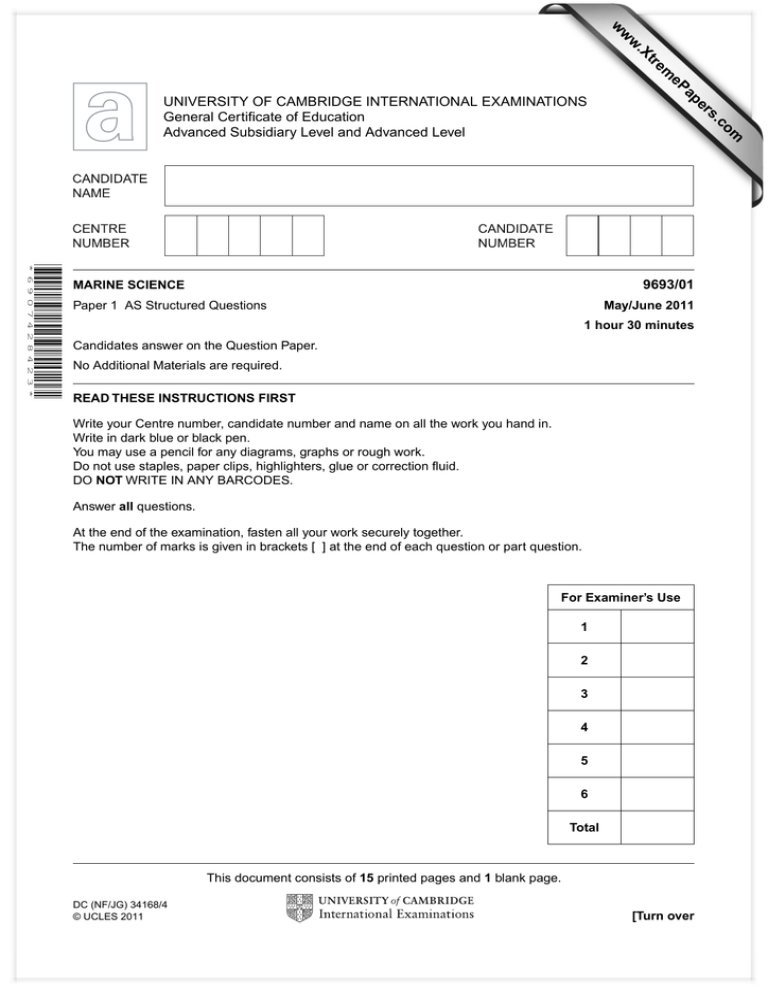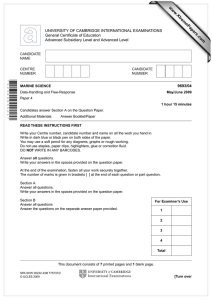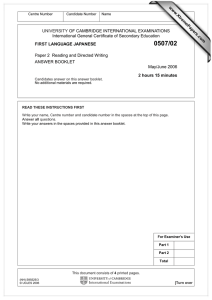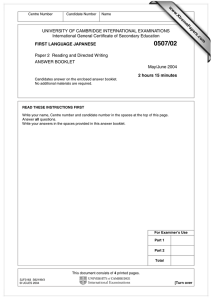www.XtremePapers.com
advertisement

w w ap eP m e tr .X w om .c s er UNIVERSITY OF CAMBRIDGE INTERNATIONAL EXAMINATIONS General Certificate of Education Advanced Subsidiary Level and Advanced Level * 6 9 0 7 4 2 8 4 2 3 * 9693/01 MARINE SCIENCE Paper 1 AS Structured Questions May/June 2011 1 hour 30 minutes Candidates answer on the Question Paper. No Additional Materials are required. READ THESE INSTRUCTIONS FIRST Write your Centre number, candidate number and name on all the work you hand in. Write in dark blue or black pen. You may use a pencil for any diagrams, graphs or rough work. Do not use staples, paper clips, highlighters, glue or correction fluid. DO NOT WRITE IN ANY BARCODES. Answer all questions. At the end of the examination, fasten all your work securely together. The number of marks is given in brackets [ ] at the end of each question or part question. For Examiner’s Use 1 2 3 4 5 6 Total This document consists of 15 printed pages and 1 blank page. DC (NF/JG) 34168/4 © UCLES 2011 [Turn over 2 1 (a) Fig. 1.1 shows a marine food web. For Examiner’s Use nurse sharks lobsters giant clams sea horses butterfly fish clown fish corals shrimps turtles turtle grass algae Fig. 1.1 (i) Name the producers shown in Fig.1.1. .......................................................... and .......................................................... [2] (ii) Explain what the arrows between the organisms in Fig. 1.1 represent. .................................................................................................................................. ............................................................................................................................. [2] (iii) The giant clam is a predator. Name two of its prey organisms. 1 ............................................................................................................................... 2 .......................................................................................................................... [2] © UCLES 2011 9693/01/M/J/11 3 (iv) In the space below draw and label the expected pyramid of energy for the following food chain. algae lobster nurse shark For Examiner’s Use [3] (b) Describe each of the following types of interrelationship and give one example of each within a marine ecosystem. (i) symbiosis ................................................................................................................. .................................................................................................................................. .................................................................................................................................. .................................................................................................................................. .................................................................................................................................. ............................................................................................................................. [3] (ii) parasitism .................................................................................................................. .................................................................................................................................. .................................................................................................................................. .................................................................................................................................. ................................................................................................................................. ............................................................................................................................. [3] © UCLES 2011 9693/01/M/J/11 [Turn over 4 2 (a) State three factors involved in the formation of atolls. 1 ....................................................................................................................................... 2 ....................................................................................................................................... 3 .................................................................................................................................. [3] (b) State two methods used to date reefs. 1 ....................................................................................................................................... 2 .................................................................................................................................. [2] (c) Table 2.1 shows the percentage of reef islands that are more than 2 metres higher than mean sea level. Table 2.1 reef islands Cocos percentage of reef islands that are more than 2 metres higher than mean sea level percentage of reef islands that are less than 2 metres higher than mean sea level 33 67 Maldives 4 Chagos 18 82 Marakei 32 68 Tuvalu 34 66 (i) Complete Table 2.1 for the Maldive Islands. (ii) Draw a bar chart to show the percentage of reef islands that are less than 2 metres higher than mean sea level. [4] © UCLES 2011 9693/01/M/J/11 [1] For Examiner’s Use 5 (d) Fig. 2.1 shows cross sections of two reefs, Fenua Tapu and Fongafale. For Examiner’s Use Fenua Tapu 4 3.5 height 3 above mean 2.5 2 sea level / m 1.5 1 0.5 mean sea level 0 200 400 distance / m 600 800 200 400 distance / m 600 800 Fongafale 5 4.5 4 3.5 height 3 above mean 2.5 2 sea level / m 1.5 1 0.5 mean sea level 0 KEY sand rubble conglomerate platform Fig. 2.1 State two differences between the two reefs shown in Fig. 2.1. 1 ....................................................................................................................................... .......................................................................................................................................... 2 ....................................................................................................................................... ..................................................................................................................................... [2] © UCLES 2011 9693/01/M/J/11 [Turn over 6 (e) The list below gives some of the stages in the formation of an atoll. • barrier reef forms • island subsides • fringing reef develops on a volcanic island • atoll forms For Examiner’s Use Write these stages in the correct sequence in the table. sequence stage 1 2 3 4 [3] © UCLES 2011 9693/01/M/J/11 7 3 (a) State what is meant by the term salinity. .......................................................................................................................................... For Examiner’s Use ..................................................................................................................................... [1] (b) Table 3.1 shows some of the ions present in fresh water and sea water. Table 3.1 percentage of total ion content type of ion sea water iron fresh water trace 0.74 calcium 1.19 16.62 magnesium 3.72 4.54 30.53 6.98 potassium 1.11 2.55 bicarbonate 0.42 31.9 sulphate 7.67 12.41 chloride 55.16 8.64 nitrate trace 1.11 0.2 trace sodium bromide Use the information in Table 3.1 to calculate the difference in the sodium chloride content of fresh water and sea water. ..................................................................................................................................... [1] © UCLES 2011 9693/01/M/J/11 [Turn over 8 (c) Fig. 3.1 shows how rainfall and salinity vary with latitude. For Examiner’s Use Key salinity rainfall 36 140 35.5 120 35 100 34.5 salinity / parts 34 per thousand 80 rainfall / cm 60 33.5 40 33 20 32.5 0 80° North 60° 40° 20° 0° 20° degrees of latitude 40° 60° 32 80° South Fig. 3.1 Use Fig. 3.1 to find each of the following. (i) the rainfall at 70° North ............................................................................................................................. [1] (ii) the range of salinity ............................................................................................................................. [1] © UCLES 2011 9693/01/M/J/11 9 (iii) Describe the changes in salinity between 40° North and 40° South. .................................................................................................................................. For Examiner’s Use .................................................................................................................................. .................................................................................................................................. ............................................................................................................................. [3] (iv) State the relationship between salinity and rainfall at latitudes 0° to 80° North. .................................................................................................................................. ............................................................................................................................. [1] (v) State two factors, other than rainfall, that affect the salinity of seawater. 1 ............................................................................................................................... 2 .......................................................................................................................... [2] (d) Suggest how global warming may affect the salinity of the oceans. Give an explanation for your answer. .......................................................................................................................................... .......................................................................................................................................... .......................................................................................................................................... .......................................................................................................................................... .......................................................................................................................................... .......................................................................................................................................... .......................................................................................................................................... ..................................................................................................................................... [4] © UCLES 2011 9693/01/M/J/11 [Turn over 10 4 (a) Give two factors required for the development of a tropical cyclone. 1 ....................................................................................................................................... 2 .................................................................................................................................. [2] (b) Table 4.1 shows the relationship between the distance from the centre of a cyclone and the amount of rainfall. Table 4.1 (i) distance from centre of cyclone / km rainfall / mm 55 864 110 336 220 108 310 30 370 10 Use the information in Table 4.1 to describe the relationship between the distance from the centre of the cyclone and rainfall. ............................................................................................................................. [2] (ii) Estimate the rainfall at 340 km from the centre of the cyclone. ............................................................................................................................. [1] (c) State two features, other than rainfall, of tropical cyclones. 1 ....................................................................................................................................... 2 .................................................................................................................................. [2] (d) Tropical cyclones develop over the sea. (i) State three destructive effects that can occur when a cyclone reaches land. 1 ............................................................................................................................... .................................................................................................................................. 2 ............................................................................................................................... .................................................................................................................................. 3 ............................................................................................................................... ............................................................................................................................. [3] © UCLES 2011 9693/01/M/J/11 For Examiner’s Use 11 (ii) Suggest one beneficial effect that may occur when a cyclone reaches land. ............................................................................................................................. [1] © UCLES 2011 9693/01/M/J/11 For Examiner’s Use [Turn over 12 5 (a) (i) State two biological reasons why the concentration of oxygen in seawater varies. 1 ............................................................................................................................... .................................................................................................................................. 2 ............................................................................................................................... ............................................................................................................................. [2] (ii) State three physical reasons why the concentration of oxygen in seawater varies. 1 ............................................................................................................................... .................................................................................................................................. 2 ............................................................................................................................... .................................................................................................................................. 3 ............................................................................................................................... ............................................................................................................................. [3] (b) Table 5.1 shows the oxygen concentration at different depths in the sea at three different locations. Table 5.1 oxygen concentration / mg per dm3 depth / metres (i) © UCLES 2011 location 1 location 2 location 3 mean 0 7.24 6.92 4.94 6.36 50 7.27 6.99 5.12 6.46 100 7.24 6.81 5.06 6.37 200 6.70 6.84 4.85 800 6.98 6.60 5.23 6.27 1000 6.96 6.64 3.68 5.76 1500 6.99 6.39 3.65 5.67 2000 6.85 6.39 3.53 5.59 2500 6.53 6.28 3.67 5.49 Calculate the mean oxygen concentration at a depth of 200 metres. Write your answer in Table 5.1. 9693/01/M/J/11 [1] For Examiner’s Use 13 (ii) Suggest why the measurements taken at each depth at each location were repeated several times. For Examiner’s Use .................................................................................................................................. .................................................................................................................................. .................................................................................................................................. ............................................................................................................................. [2] © UCLES 2011 9693/01/M/J/11 [Turn over 14 6 (a) Describe the theory of plate tectonics. .......................................................................................................................................... .......................................................................................................................................... .......................................................................................................................................... .......................................................................................................................................... .......................................................................................................................................... .......................................................................................................................................... .......................................................................................................................................... ..................................................................................................................................... [4] (b) Tectonic processes lead to the formation of mid-ocean ridges, tsunamis and abyssal plains. Describe each of these features and explain how they are formed by tectonic processes. (i) mid-ocean ridges .................................................................................................................................. .................................................................................................................................. .................................................................................................................................. ............................................................................................................................. [2] (ii) tsunamis .................................................................................................................................. .................................................................................................................................. .................................................................................................................................. ............................................................................................................................. [2] (iii) abyssal plains .................................................................................................................................. .................................................................................................................................. .................................................................................................................................. ............................................................................................................................. [2] © UCLES 2011 9693/01/M/J/11 For Examiner’s Use 15 (c) Explain why water coming from hydrothermal vents is hot and rich in minerals. (i) hot ............................................................................................................................ ............................................................................................................................. [1] (ii) rich in minerals ......................................................................................................... ............................................................................................................................. [1] © UCLES 2011 9693/01/M/J/11 For Examiner’s Use 16 BLANK PAGE Permission to reproduce items where third-party owned material protected by copyright is included has been sought and cleared where possible. Every reasonable effort has been made by the publisher (UCLES) to trace copyright holders, but if any items requiring clearance have unwittingly been included, the publisher will be pleased to make amends at the earliest possible opportunity. University of Cambridge International Examinations is part of the Cambridge Assessment Group. Cambridge Assessment is the brand name of University of Cambridge Local Examinations Syndicate (UCLES), which is itself a department of the University of Cambridge. © UCLES 2011 9693/01/M/J/11







